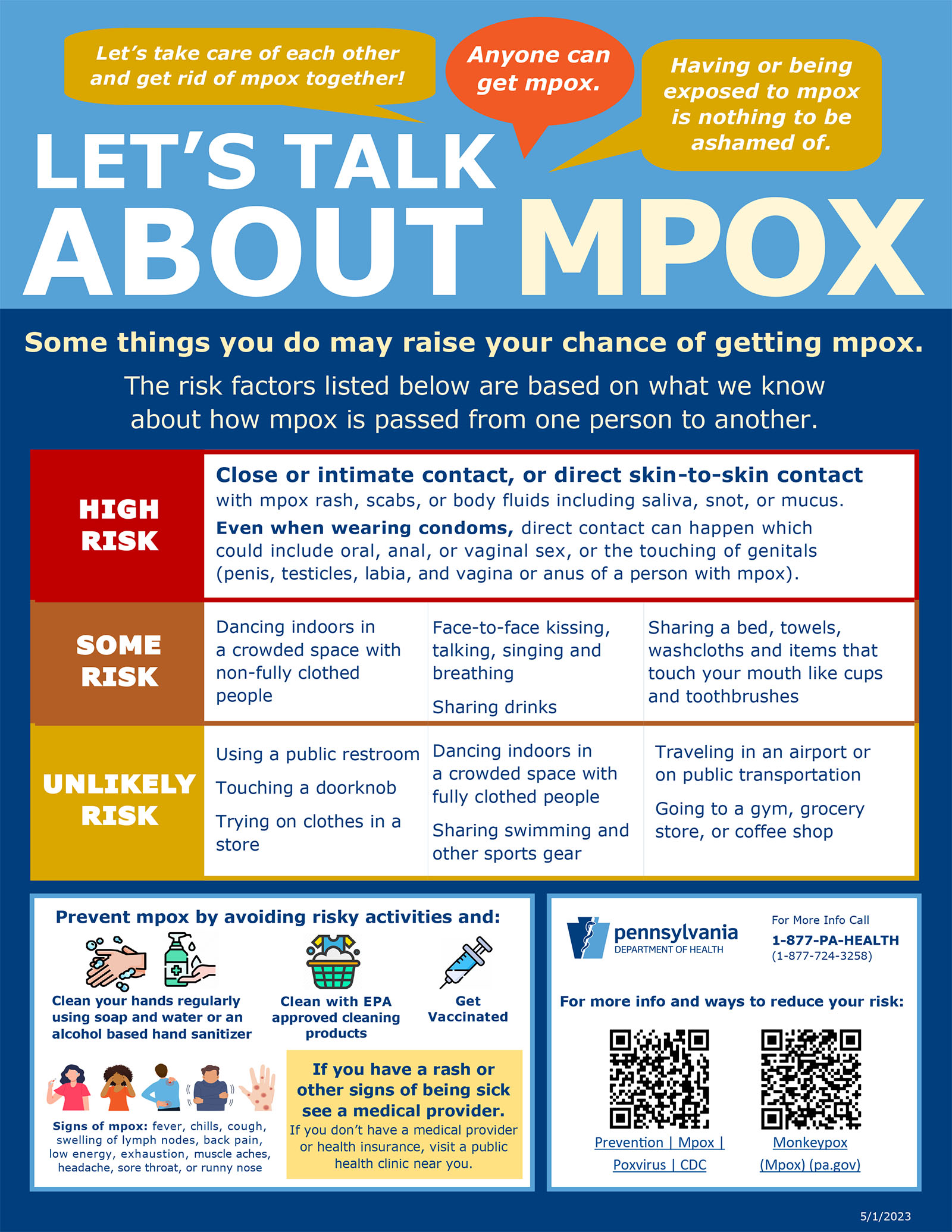CDC recommends vaccination against mpox if:
- You had known or suspected exposure to someone with mpox
- You had a sex partner in the past 2 weeks who was diagnosed with mpox
- You are a gay, bisexual, or other man who has sex with men or a transgender, nonbinary, or gender-diverse person who in the past 6 months has had any of the following:
- A new diagnosis of one or more sexually transmitted diseases (e.g., chlamydia, gonorrhea, or syphilis)
- More than one sex partner
- You have had any of the following in the past 6 months:
- Sex at a commercial sex venue (like a sex club or bathhouse)
- Sex related to a large commercial event or in a geographic area (city or county for example) where mpox virus transmission is occurring
- Sex in exchange for money or other items
- You have a sex partner with any of the above risks
- You anticipate experiencing any of the above scenarios
- You have HIV or other causes of immune suppression and have had recent or anticipate future risk of mpox exposure from any of the above scenarios
- You work in settings where you may be exposed to mpox:
- You work with orthopoxviruses in a laboratory
How the vaccine is given
- The vaccine will be given between the top layers of your skin; this is called an intradermal vaccination. It can be placed in your forearm or other areas, including your upper back just below the shoulder blade or the skin of your shoulder above the deltoid muscle.
- If preferred, you can also ask for the vaccine to be given to you “subcutaneously.” This means that the vaccine will be injected in the fat layer underneath the skin on the back of your upper arm (triceps).
- If you have ever had keloid scars (thick, raised scars) or are under 18, ask for the vaccine to be given to you subcutaneously.
- Getting the vaccine intradermally or subcutaneously appears to be equally effective against mpox.
Although early findings suggest that the first dose of JYNNEOS vaccine gives some protection against mpox, two doses are recommended to provide stronger protection. Whether you get the vaccine subcutaneously or intradermally, you should still get two doses. The second dose should be given 4 weeks (28 days) after the first dose. If you can’t get your second dose on time, you should get it as soon as possible to complete the series.
If you don’t want the vaccine given in the skin of your forearm, ask to get it in the skin of your upper back or the skin of your shoulder instead. You can also ask to be given the vaccine subcutaneously in the fat layer underneath the skin on the back of your upper arm.
Side effects
Not everyone has side effects, but some people do. The most common side effects after JYNNEOS vaccination are pain, redness, and itching at the spot where the vaccine is given. You might also experience fever, headache, tiredness, nausea, chills, and muscle aches. These are signs that your immune system is responding, not that you’re getting sick.
When JYNNEOS vaccine is given intradermally, some people have reported less pain after vaccination but more side effects like itching, swelling, redness, thickening of the skin, and skin discoloration at the spot where the vaccine was given. Some of these side effects may last for several weeks. If you have concerns about receiving the vaccine intradermally, you can ask for the vaccine to be given to you subcutaneously in the fat layer underneath the skin on the back of your upper arm (triceps).
How long it takes for the vaccine to work
You can start to have an immune response after the first dose of JYNNEOS, but it takes two weeks after the second dose to be the most protected.
It’s not known how long protection might last, or if protection might decrease over time. CDC is analyzing the current data and conducting studies to enhance the knowledge on how well the JYNNEOS vaccine works during the current mpox outbreak, as well as how long protection might last. These studies will be used to make future vaccine recommendations.
Vaccine cost
- Mpox vaccines are free. Providers must give you the vaccine regardless of your ability to pay the administration fee.
- The providers may bill a program or plan that covers the mpox vaccine administration fee (like your private insurance or Medicare/Medicaid).

